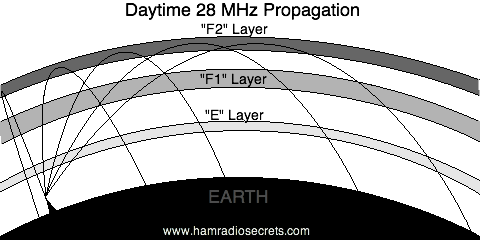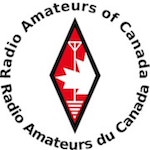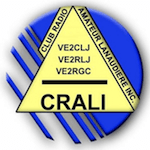10 Meter Ham Radio
The 10 meter ham radio band of frequencies has much to offer.
This Page Covers
1. Most "Bang"
2. 10M Propagation
3. Monitoring
4. Ten Meter Dipole
- 10 meters (28.0-29.7 MHz) offers superb long distance contacts (DX) even on very low power (QRP).
- An antenna for ten meters is smaller and easier to build than for any other HF ham radio bands.
Most "Bang For The Buck"
In other words, here is a band on which you are likely to get the "biggest bang for the buck" than on any other HF band ... if you are looking for DX that is. Why?

Source: https://sohowww.nascom.nasa.gov/data/realtime/eit_284/512/latest.jpg
For more info on the sun, visit: https://sohowww.nascom.nasa.gov/classroom/classroom.html
Our sun's activity pulsates every 11 years or so. This activity is characterized by "spots" appearing on the outer limits of the sun's atmosphere. These spots are huge nuclear explosions sending shock waves of radiation in the solar system.
Solar Cycle 25, the one currently in progress, started on November 17, 2019. Its activity appears to have peaked on June 8, 2024, but it will continue to have a favorable influence on 10 meter propagation for another 5 years or so before going relatively quiet.
And even beyond that there will still be occasional 10 meter openings!
How?
10 Meter Propagation
The "solar wind", generated by the sun's explosions, impacts the earth's upper atmosphere, called the ionosphere. When it does, ionized layers (called "F2" and "F1") form in the ionosphere between about 160 and 500 km above the earth's surface.

The "F2" layer acts like a mirror to a 10 meter radio signal. The "F2" reflects the signal back to earth, thousands of kilometers beyond your antenna.
Often, the signals you hear have "bounced" a few times between the "F2" layer and the earth's surface. This is commonly called "skip".
When that happens, radio signals can be exchanged between ham radio stations located on opposite sides of the earth!
Monitoring Ten Meters for Activity
What's going on right now on 10 meters? You can easily find out ...
- By scanning across the ten meter band, of course! If you don't hear any stations, that does not mean that there is no activity. It may just mean that propagation does not favor your location at that moment. You can still find out if there is any activity elsewhere in the world by...
- By monitoring 28.200 MHz for any sign of a beacon. The NCDXF/IARU International Beacon Project has 18 beacons scattered around the world. Each beacon transmits once every three minutes, 24 hours a day. The project's website gives details about the transmission schedule and what is transmitted, at what power.
- By consulting DX clusters such as the ones available at
- https://www.dxwatch.com/ or
- https://rsgb.org/main/operating/dx-cluster/, for example.
- By consulting the Reverse Beacon Network where ham radio stations report what stations they hear, on what band (specific frequency), how well they are heard (dB) and at what time.
A Simple
10 Meter Ham Radio
Antenna
During the most active years of a solar cycle, often a simple dipole will work wonders. It's easy to put one up because of its relatively small size.
The formula to calculate the length of a dipole on 10 meters is:
length (meters) = 142.4 / 28.0 MHz which gives 5.086 meters.
length (feet) = 467.2 / 28.0 MHz which gives 16 ft. 8 1/4 ins.
Of course, as you operate higher in the band, that dipole will be too long. You can either
- Trim it down to resonance (cut & try ... a few
centimeters on each side of the dipole at a time). For example, a 29 MHz
dipole will be about 17.5 cm shorter than the 28 MHz dipole.
- Or use an antenna tuner. The automatic antenna tuner of some transmitters might have enough capacitive range to overcome and cancel the inductive reactance of the dipole as you move up in frequency within the 10 meter ham radio band.
The Years Of "DX" Ahead
The sun's cycle 25 activity is slowly subsiding. Yet, it will still throw enough energy toward earth to maintain the "F layer" in good enough shape, at least sometimes, to continue reflecting 10 meter radio signals well after 2030.
Even during years of low sunspot activity, 10 meters can sometimes offer "DX openings". The best way to take advantage of them is to have a good 10 meter ham antenna system and an excellent receiver.
10 meter ham radio is my favorite for low power DX.
It's 1.7 MHz wide! That's a big slice of radio spectrum, as much as all the lower bands put together! Lots of "elbow room". I'll see you there!
10 Meter Ham Radio
Transceiver? Kit? SDR?
Start here..
73 de VE2DPE
Claude Jollet
104-30 avenue des Berges,
Notre-Dame-des-Prairies, Québec, Canada J6E 1M9
QTH Locator: FN36gb
Disclosure
If
you make a purchase via a link on this site, I may receive a small
commission on the transaction, at no extra cost to you. Thank you!
(One word queries work best)
FOUND THIS
SITE
USEFUL?
VE2DPE
Is a member
in good standing
of



Also a proud member of an international community of solopreneurs
using SoloBuildIt!
(SBI!)
to promote my self-published eBooks
since 2005.
See my review
of this unique product for online businesses.
CQ CQ CQ
If you have a question, a comment or a topic you would like me to cover, please do not hesitate to ask here.


